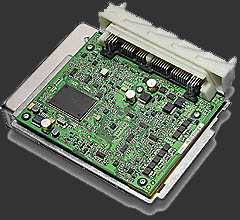Transmission Control Unit
A Transmission Control Unit is a device that controls modern electronic automatic transmissions. A Transmission Control Unit generally uses sensors from the vehicle as well as data provided by the Engine Control Unit to calculate how and when to change gears in the vehicle for optimum performance, fuel economy and shift quality.
Electronic automatic transmissions have been shifting from purely hydromechanical controls to electronic controls since the early 1990’s. Since then, development has been iterative and today designs exist from several stages of electronic automatic transmission control development.
The evolution of the modern automatic transmission and the integration of electronic controls have allowed great progress in recent years. The modern automatic transmission is now able to achieve better fuel economy, reduced engine emissions, greater shift system reliability, improved shift feel, improved shift speed and improved vehicle handling. The immense range of programmability offered by a Transmission Control Unit allows the modern automatic transmission to be used with appropriate transmission characteristics for each application.
Input Parameters
The typical modern Transmission Control Unit uses signals from engine sensors, automatic transmission sensors and from other electronic controllers to determine when and how to shift.
- Vehicle Speed Sensor
- (VSS) This may also be known as an output speed sensor (OSS). This sensor sends a varying frequency signal to the Transmission Control Unit to determine the current shaft speed of the output shaft or differential in a typical vehicle. The Transmission Control Unit uses tire size, gear ratios and final drive ratio to calculate the current vehicle speed.
- Turbine Speed Sensor
- (TSS) This may also be known as an input speed sensor (ISS). This sensor sends a varying frequency signal to the Transmission Control Unit to determine the current shaft speed of the input shaft or torque converter. The Transmission Control Unit uses this shaft speed to determine slippage across the torque converter and potentially to determine the rate of slippage across the bands and clutches.
- Transmission Fluid Temperature
- (TFT) This may also be known as Transmission Oil Temperature (TOT). This sensor determines the fluid temperature inside the transmission. This allows the Transmission Control Unit to modify the line pressure and solenoid pressures according to the changing viscosity of the fluid based on temperature. This can provide for more appropriate shifing in extreme temperatures and allow for temperature failsafe systems to take control.
Output Parameters
The typical modern Transmission Control Unit sends out signals to shift solenoids, pressure control solenoids, torque converter lockup solenoids and to other electronic controllers.
- Shift Solenoid
- Modern electronic automatic transmission have electrical solenoids which are activated to change gears. These solenoids range from very simplistic control in older automatic transmission designs to extremely complicated in very new automatic transmission designs. The way in which the soleniod is activated and when it is activated is chosen by the manufacturer of the transmission and can vary greatly from vehicle to vehicle.
- Pressure Control Solenoid
- Modern electronic automatic transmissions are still fundamentally hydraulic. This requires precise pressure control. Older automatic transmission designs may only use a single line pressure control soleniod which modifies pressure across the entire transmission. Newer automatic transmission designs often use many pressure control solenoids and sometimes allow the shift solenoids themselves to provide precise pressure control during shifts by ramping the solenoid on and off. The shift pressure affects the shift harness and shift speed.
- Torque Converter Clutch Solenoid
- (TCC) Most electronic automatic transmissions utilize a TCC solenoid to lock the torque converter electronically. Once locked, the torque converter no longer applies torque multiplication and will spin at the same speed as the engine (assuming the converter is fully locked). This provides a major increase in fuel economy and modern designs attempt to provide partial lockup in lower gears to improve fuel economy further.
